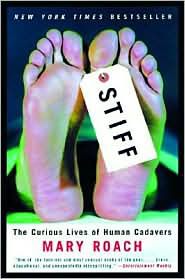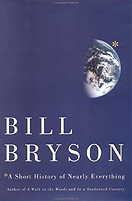Reviews: Science
August 8, 2008
Stiff: The Curious Lives of Human Cadavers - Mary Roach
Macabre. Gross. Funny, in a twisted, fascinating way. What does happen to our bodies once we are dead and gone? Ashes to ashes and dust to dust, eventually and in most cases, unless you've donated your body to science and then the process is either sped up, as it is dipped in a tub of lye, or delayed indefinitely through plastination. In Stiff: The Curious Lives of Human Cadavers, author Mary Roach takes us on a wild romp through history and science, describing in unsettling detail how cadavers have been used, and are used, in medical research. Although the book is weirdly entertaining, given the subject matter, Roach is always respectful of the bodies, and the people who have donated them.
"The human head is of the same approximate size and weight as a roaster chicken. I have never before had occasion to make the comparison, for never before today have I seen a head in a roasting pan. But here are forty of them, one per pan, resting face-up on what looks to be a small pet-food bowl. The heads are for plastic surgeons, two per head, to practice on. I'm observing a facial anatomy and face-lift refresher course, sponsored by a southern university medical center and led by a half-dozen of America's most sought-after-face-lifters. The heads have been put in roasting pans - which are of the disposable aluminum variety - for the same reason that chickens are put in roasting pans: to catch the drippings. Surgery, even surgery upon the dead, is a tidy, orderly affair."
In the chapter entitled "Crimes of Anatomy", Roach takes us back before the time where there was a legal process in place to donate one's body to science. In the early 1800s teachers of anatomy had to resort to other means of acquiring bodies on which to practice. Body snatching from recently dug graves was the more usual method, and there was a vigorous trade in the practice. The problem was that nobody wanted to be dissected. The common view of life after death was of the whole body making its way to heaven. Dissection was something only done to the bodies of executed mass murderers.
Continue reading "Stiff: The Curious Lives of Human Cadavers - Mary Roach"
Posted by elise at 5:54 PM | Permalink | Email to a friend
January 13, 2005
A Short History of Nearly Everything - Bill Bryson
If only all science books were as entertaining as Bill Bryson's A Short History of Nearly Everything. Bryson explains the major scientific theories known to man with masterful storytelling skills. Weaving in richly researched details on the lives and characteristics of the foremost historical scientific figures, Bryson discourses on everything from the big bang theory and quantum physics, to paleontology and plate tectonics. As he put it, the book is about "...how we went from there being nothing at all to there being something, and then how a little of that something turned into us, and also what happened in between and since." Not just detailing what we know, Bryson describes how we learned what we now know.
Continue reading "A Short History of Nearly Everything - Bill Bryson"
Posted by elise at 7:12 PM | Permalink | Email to a friend
June 8, 2003
"Measure of Reality" Alfred W. Crosby
For any of you interested in History of Science and its impact on society, this is a must read.
The Measure of Reality explores another angle of the "Guns, Germs and Steel" line of investigation. Namely, the origins of why did the West, a crude, backwater region; evolve to its significant role in the modern world. Crosby postulates that a shift of Western mindset from qualitative to quantitative thinking, from 1250 - 1600, triggered this power shift.
He provides fascinating detail on many, varied topics such as the development of quantitative music notation (required to perform complex, polyphonic music) and the adoption of double entry bookkeeping. This last required the adoption of “Arabic” numerals before being feasible. Think about a ledger kept in Roman numerals.
Continue reading ""Measure of Reality" Alfred W. Crosby"
Posted by mvestrich at 9:48 PM | Permalink | Email to a friend
May 15, 2003
The Mind and the Brain - Schwartz and Begley
In The Mind and the Brain: Neuroplasticity and the Power of Mental Force brain researcher Jeffrey Schwartz and Wall St. Journal reporter Sharon Begley explore the extraordinary discoveries in brain research over the last 20 years. When we were growing up we were taught that the brain pretty much is fixed by age 10, and after that no new neurons are made. For a 100 years it was believed that if you had a stroke and lost functioning over one part of your body as a result of damage to the brain, you just had to live with it. New imaging techiniques in the last quarter century have enabled researchers to precisely map functioning of different parts of the brain, down to the millimeter. What has been discovered is that new neural pathways are being forged in the brain throughout our whole lives, depending on how we use our mind. Wherever we focus our attention is where new neural connections will be made.
Continue reading "The Mind and the Brain - Schwartz and Begley"
Posted by elise at 11:03 PM | Permalink | Email to a friend

